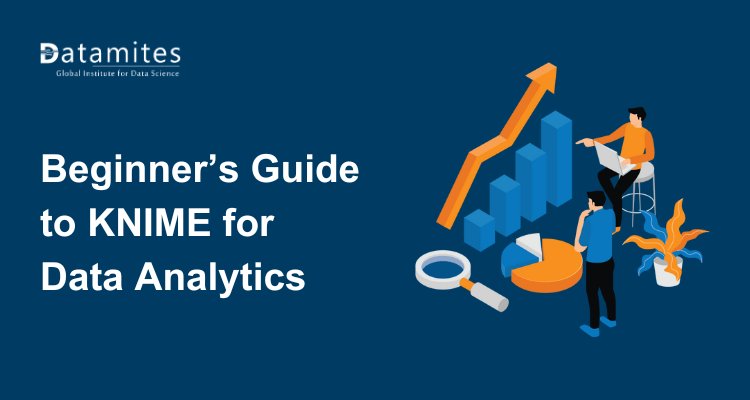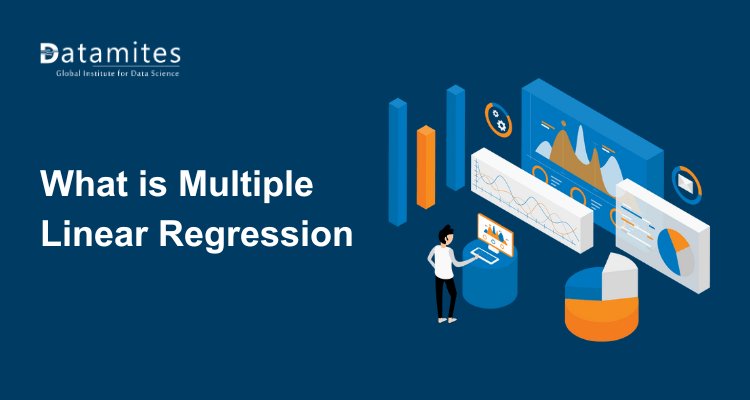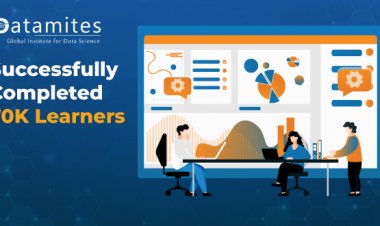Beginner’s Guide to KNIME for Data Analytics
Explore KNIME software with this beginner’s guide to data analytics. Learn how to build KNIME workflows, create ETL pipelines, and integrate data seamlessly ideal for aspiring data analysts starting their analytics journey.

In today’s data-driven world, organizations rely heavily on advanced analytics to make informed business decisions. For aspiring data analysts and professionals entering the field, mastering tools that simplify data processing and analytics is crucial. One such powerful platform is KNIME software. Known for its intuitive interface and wide range of features, KNIME has emerged as a leading solution for data analysts seeking to streamline data workflows and build efficient ETL pipelines.
This guide is a comprehensive resource for beginners who want to explore KNIME and understand how it can transform their data analytics journey.
What is KNIME?
KNIME, which stands for Konstanz Information Miner, is an open-source model data analytics, reporting, and integration platform. Designed for ease of use, KNIME enables users to perform data analysis, machine learning, and predictive modeling without the need for extensive programming knowledge. Its visual interface allows data analysts to create complex workflows using a drag-and-drop methodology, making it particularly attractive for beginners.
One of the core strengths of KNIME is its ability to handle a wide variety of data sources, including spreadsheets, databases, cloud platforms, and big data frameworks. By leveraging KNIME download, users can install the software on their local machines and access an extensive set of features for analytics. Furthermore, the KNIME Hub serves as a central repository where users can explore pre-built workflows, extensions, and community-driven resources, enhancing both learning and practical application.
KNIME offers over 300 connectors, allowing data import from databases, spreadsheets, cloud services, and APIs within a single workflow. This flexibility streamlines data consolidation and analysis from multiple sources.
For aspiring data analysts, understanding KNIME’s purpose is critical. It is not just a tool for cleaning and visualizing data; it also supports ETL pipelines, advanced predictive analytics, and integration with programming languages such as Python and R, making it versatile for various business and research applications.
What are the key features of KNIME
KNIME offers a comprehensive suite of features that make it an ideal platform for data analysts and beginners in the field. Understanding these features is essential for leveraging the full potential of the software:
- Visual Workflow Creation – KNIME allows users to build KNIME workflows using a visual, node-based approach. Each node represents a specific task, such as data import, transformation, or modeling, and can be connected to create a complete analytics pipeline. This reduces the need for manual coding while maintaining flexibility for advanced users.
- Data Preprocessing and ETL Pipelines – A significant part of any data analyst project involves extracting, transforming, and loading data efficiently. KNIME supports robust ETL pipelines, enabling data analysts to clean, merge, and manipulate data from multiple sources seamlessly.
- Integration with Programming Languages – While KNIME is largely no-code, it also supports integration with Python, R, Java, and SQL. This makes it possible to combine visual workflows with custom scripts, enhancing analytical capabilities.
- Machine Learning and Predictive Analytics – KNIME comes equipped with a variety of machine learning nodes for classification, regression, clustering, and more. Beginners can experiment with predictive and prescriptive analytics models without writing complex algorithms from scratch.
- Data Visualization and Reporting – Effective analytics require meaningful data visualization. KNIME provides data analyst tools for charts, tables, and dashboards, helping data analysts present insights clearly and professionally.
- Extensibility through KNIME Hub – The KNIME Hub is a repository of workflows, nodes, and extensions shared by the KNIME community. Beginners can download and explore these workflows, accelerating their learning and implementation process.
By leveraging these features, data analysts can efficiently transform raw data into actionable insights, streamline reporting, and improve decision-making processes.
Refer to the articles below:
- Understanding Conditional Probability for beginner
- Categorical Analysis: Methods, Applications, and Insights
- Star Schema vs Snowflake Schema
KNIME workflow for beginners
A KNIME workflow is essentially a sequence of connected nodes representing steps in a data analysis process. Each node performs a specific function, such as reading data, filtering, or applying a machine learning model. Understanding how workflows operate is key for beginners to gain confidence in using KNIME effectively.
For instance, a typical workflow for a data analyst might start with importing data from an Excel sheet or database, followed by data cleansing nodes that handle missing values and remove duplicates. Next, transformation nodes might normalize the data, calculate new variables, or filter datasets based on specific criteria. Finally, visualization or machine learning nodes generate insights or predictive models, which can be exported for reporting.
Using pre-built workflows from the KNIME Hub can help beginners understand the structure and logic of effective analytics pipelines. These workflows provide practical examples that can be modified to suit different datasets and analytical goals.
Moreover, KNIME supports real-time monitoring of workflows, enabling users to troubleshoot and optimize each step. This feature is especially beneficial for those who are new to ETL processes or data pipeline management. According to a report by ResearchGate, more than 70% of big data initiatives depend on ETL tools to ensure efficient data integration and preparation.
How to build your first workflow in KNIME
Building your first KNIME workflow is straightforward, thanks to the platform’s intuitive interface. Here’s a step-by-step guide for beginners:
- Install KNIME Software – Start by downloading KNIME from the official site using KNIME download. Follow the installation instructions for your operating system.
- Set Up Your Workspace – Upon opening KNIME, set a workspace folder where all your workflows, data files, and configurations will be stored.
- Import Data for reporting – Use the “File Reader” or “Excel Reader” nodes to import datasets. KNIME supports a wide variety of data formats, making it convenient for beginners working with real-world data.
- Add Data Preprocessing Nodes – Drag nodes like “Missing Value,” “Row Filter,” or “Column Filter” to clean and structure your dataset. This step is crucial in preparing data for analysis.
- Apply Analytics or Machine Learning Nodes – Depending on your goal, you can add nodes for clustering, classification, or regression. For example, the “Decision Tree Learner” node allows you to create predictive models with minimal effort.
- Visualize Data for analysis – Add charting or reporting nodes to create visualizations such as bar charts, scatter plots, or pivot tables.
- Run the Workflow – Execute the workflow to process your data. KNIME provides detailed logs and outputs for each node, enabling you to track and debug the analysis.
- Save and Share the data – Save your workflow locally or share it through the KNIME Hub to collaborate with other data analysts.
By following these steps, beginners can build functional workflows that process data efficiently and generate actionable insights.
Benefits of KNIME for analysis
KNIME offers numerous benefits for data analysts, making it a valuable addition to any analytics toolkit:
- User-Friendly Interface – Beginners can quickly learn to build workflows without needing advanced coding skills.
- Time Efficiency for the tasks – Pre-built nodes and templates reduce the time required to design ETL pipelines and perform repetitive tasks.
- Versatility of the software – KNIME supports a variety of data types, sources, and integration options, making it suitable for diverse analytics projects.
- Scalability of datasets – Workflows created in KNIME can handle small datasets as well as large-scale enterprise data.
- Community Support – The KNIME Hub provides access to thousands of workflows, nodes, and extensions shared by the global community. Beginners can learn from real-world examples and accelerate their skill development.
- Career Advancement – For aspiring data analysts, proficiency in KNIME opens doors to roles in business intelligence, data science, and predictive analytics. Many organizations prefer candidates familiar with KNIME workflows for managing complex data pipelines efficiently.
- Integration with Advanced Analytics Tools – KNIME’s compatibility with Python, R, SQL, and other analytics platforms allows users to expand their workflow capabilities beyond the native nodes.
Overall, KNIME empowers beginners and professionals alike to perform end-to-end data analysis, from raw data ingestion to generating actionable insights, without being overwhelmed by complex programming requirements.
Refer to the articles below:
- How to Become a Data Analyst in Chennai
- Data Analyst Career Scope in Chennai
- Data Analyst Course Fee in Chennai
For beginners looking to start a career as a data analyst, KNIME software provides an accessible yet powerful platform for learning and executing data analytics. By understanding the basics of KNIME workflows, leveraging the resources available on KNIME Hub, and building effective ETL pipelines, users can transform raw data into actionable insights efficiently.
KNIME’s visual workflows, data preprocessing, programming integrations, and machine learning features make it beginner-friendly and versatile. Its community-driven ecosystem offers practical learning, empowering aspiring data analysts to clean, analyze, model, and visualize data effectively.
DataMites Institute stands out by offering a diverse range of top IT courses in Coimbatore, including Data Science, Machine Learning, Artificial Intelligence, Python, IoT, Data Engineering, and data analyst courses in Coimbatore. The institute emphasizes hands-on learning, allowing students to gain practical experience through real-world projects, certified internships, and globally recognized certifications accredited by IABAC and NASSCOM FutureSkills, along with dedicated placement support.
With both classroom and online training options, DataMites has established a strong presence across India. From data analyst training in Chennai to centers in Bangalore, Pune, Mumbai, Ahmedabad, Coimbatore, Hyderabad, Delhi, Jaipur, Kochi, and Kolkata, the institute provides flexible learning opportunities that equip students with industry-ready skills and pave the way for successful careers in data analytics.





